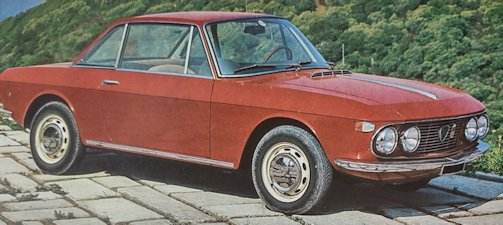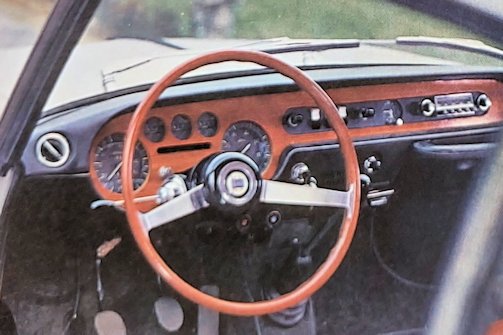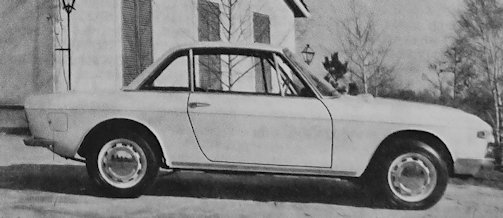Lancia Fulvia coupé S1
 |
|
|
Manufacturer: |
Lancia |
|
Production: |
1965 to 1970 |
|
Class: |
Sports car |
|
Designer: |
Piero Castagnero |
|
Body styles: |
coupé |
|
Doors: |
2-door |
|
Chassis/body: |
Steel |
|
Drive: |
front-wheel-drive |
|
Engine Type: |
V4 |
|
Displacement: |
1216 cc |
|
Engine location: |
Front-engine |
|
Engine power: |
80 bhp |
|
Transmission: |
4-5 speed manual |
|
Fuel: |
petrol |
|
Wheelbase: |
91.73 in, 2,330 mm |
|
Length: |
156.50 in, 3,975 mm |
|
Width: |
61.22 in, 1,555 mm |
|
Height: |
51.18 in, 1,300 mm |
The Lancia Fulvia coupé Series 1 is an automobile of the Italian manufacturer Lancia from 1965 to 1970.
History
The Fulvia Coupé, which was presented at the 1965 Geneva Show. is entirely the creation of the Turin concern. for they are responsible even for
the design of the coachwork. the lines of which show all the originality and harmony that traditionally distinguish Lancia products.
From the technical point of view, the Fulvia Coupé has almost the same technical components as the Saloon, but exploits more fully the great possibilities of the touring model. The narrow-angle Vee four-cylinder engine has two camshafts, one for each cylinder block, and the engine capacity has been increased from the 1.091 cubic centimetres of the saloon to 1,216 cubic centimetres, the compression ratio rising from 7.8 to 9. These modifications, together with the mounting of two horizontal twin barrel Weber or Solex carburettors, allow the engine to develop no less than 80 hp DIN at 6,000 rpm with a specific power of 65B hp/l.
As in the saloon. a transverse leaf spring is used on the front suspension; at the rear there is a rigid axle completed by two semi-elliptic leaf springs.
On the road, the Fulvia Coupé is one of the few cars that presents no problems for the driver and gives complete confidence in its capabilities from
the word goes. Its behaviour is neutral (understeer typical of a front-wheel drive car can only be produced by trying to take a tight corner much too fast). Its
fine road-holding qualities are particularly evident on bad road surfaces where little adhesion is offered, when the performance a good driver manages to
obtain is really exceptional. The steering, too, is beautifully light and positive. The disc brakes all round is extremely powerful and, as a servo brake is fitted, only light pedal pressure is needed to produce reliable, progressive braking.
The front seats are particularly comfortable and two additional passengers can be accommodated for short journeys on the back seat. Riding comfort is greatly enhanced by the very quiet engine that has no vibration periods, and designing that cuts wind noise down to a minimum even at high speeds.
True to Lancia traditions of providing deluxe details even in its smaller cars. this car has a very attractive trim. Behind the wood-rim steering wheel there is a handsome French-polished wooden facia with the instruments grouped nicely under the driver's eye. Brake and clutch pedals are hung and there is an organ-type accelerator, The upholstery and floor covering are tasteful, and there are red warning lights set into both doors that come on automatically as soon as they are opened. Both the bonnet and the capacious boot have automatic inspection lamps.

Designed by Piero Castagnero, who according to his statements was inspired by the Riva motorboat, the Fulvia Coupé (built in the Lancia factory in Chivasso) is a 2-plus-2-seater sports Berlinetta, with a well-finished look down to the smallest details (such as the dashboard upholstered in real wood) assisted by a racing driving set-up. In reality, the similarities of the front and the side line with the prototype presented by Giovanni Michelotti at the 1961 Turin Motor Show, on Fiat 1300/1500 mechanics, are quite evident.
Built on the shortened platform (the wheelbase was 2330 mm, i.e., 150 mm shorter) than the sedan, the compact Lancia coupé was powered, at the time of its debut, by a 1216 cm³ 80 HP version of the V4. The power supply was with two double-choke Solex carburettors, while the gearbox (4-speed) had a joystick between the seats. Thanks to the low weight of 950 kg, the small sports car reached 160 km/h.
PERFORMANCE
- Engine capacity: 74.20 cu in, 1,216 cu cm
- Fuel consumption: 31.4 m/imp gal, 26.1 m/US gal, 9 1 x 100 km
- Max speed: 99.4 mph, 160 km/h
- Max power (DIN): 80 hp at 6,000 rpm
- Max torque (DIN): 77 1b ft, 10.6 kg m at 4,000 rpm
- Max engine rpm: 6,200
- Specific power: 65.8 hp/l
- Power-weight ratio: 25.6 lb/hp, 11.6 kg/hp
- Acceleration: standing 1/4 mile 20 sec, 0—50 mph (O—80 km/h)10.5 sec
- Max speeds: 29.2 mph, 47 km/h in 1st gear; 49.7 mph, 80 km/h in 2nd gear; 75.8 mph, 122 km/h in 3rd gear; 99.4 mph, 160 km/h in 4th gear
With the introduction of the 87 bhp 1298 engine of the Rallye 1.3, the engine of the 1.2 coupé was increased to 1231 cm³ to standardize the production cycle and the offer of the 1.2 engine (maintained for tax reasons only). The new engines were modified in the bank angle, reducing it to 12°45'28", to obtain a larger bore. It was the prelude to the launch of a real sports version to be raced in Rally, which took place the following year with the presentation of the Rallye 1.3 HF version.
Thanks to these numerous sporting achievements, the Fulvia coupé became one of the most victorious and then desired production cars, so much so that for the first time a coupé outsold the sedan from which it was derived.

Technical
-
Lancia Fulvia coupé S1 Technical details and specifications (1965-1970)
ENGINE
location front
4 stroke; cylinders: 4, Vee-slanted at 12°35'
bore and stroke:2.99 x 2.64 in, 76 x 67 mm
engine capacity: 74.20 cu in, 1,216 cu cm
compression ratio: 9
cylinder block:cast iron
cylinder head: light alloy
crankshaft bearings: 3
valves: 2 per cylinder,Vee-slanted at 60°,rockers
camshafts: 2, overhead
lubrication: rotary pump, full flow filter
carburation:2 Weber or Solex downdraught twin barrel carburettors
fuel feed: mechanical pump
cooling system: waterTRANSMISSION
driving wheels: front
clutch: single dry plate
gearbox: mechanical; gears: 4 + reverse
synchromesh gears: all
gearbox ratios: 1st 3.690, 2nd 2.179, 3rd 1.419, 4th 1, rev 4.112
gear lever: central
final drive: hypoid bevel
axle ratio: 3.909.CHASSIS
type integral
front suspension: independent, wishbones, lower transverse leafspring, anti-roll bar, telescopic dampers
rear suspension: rigid axle, semi-elliptic leafsprings, transverse linkage bar, anti-roll bar, telescopic dampers.STEERING
worm and roller
turns of steering wheel lock to lock: 4.25.
turning circle (between walls):34.4 ft. 10.5 m
BRAKES
disc (front diameter 10.16 in, 258 mm, rear 10.51 in, 267 mm), double circuit.ELECTRICAL EQUIPMENT
voltage: 12 V
battery: 42 Ah
generator type: dynamo, 360 W
ignition distributor: Marelli
headlamps: 4.DIMENSIONS AND WEIGHT
wheel base: 91.73 in, 2,330 mm
front track: 51.18 in, 1,300 mm
rear track: 50.39 in, 1,280 mm
overall length: 156.50 in, 3,975 mm
overall width: 61.22 in, 1,555 mm
overall height: 51.18 in, 1,300 mm
ground clearance: 4.72 in, 120 mm
dry weight: 2,040 1b, 925 kg© Motor car History
Service
-
Lancia Fulvia coupé S1 Service Guide (1965-1970)
Fuel: 92 oct petrol
Engine oil change: 6.34 imp pt, 7.61 US pt. 3.6 1, SAE 10W-20 (winter) 20W-30 (summer), change every 4,300 miles, 7,000 km
Total lubricating system capacity: 7.04 imp pt, 8.46 US pt
Gearbox and final drive oil: 4.40 imp pt. 5.28 US pt. 2.5 1, SAE 90, change every 8,700 miles, 14,000 km
Greasing: every 4,300 miles, 7,000 km, 11 points
cooling system capacity: 11.09 imp pt, 13.32 US pt
Tappet clearances: inlet 0.006 in, 0.15 mm, exhaust 0.010 in, 0.25 mm
Valve timing: inlet opens 17° before tdc and closes 65° after bdc,exhaust opens 65° before bdc and closes 17° after tdc
Normal tyre pressure: front 26 psi, 1.8 atm, rear 26 psi, 1.8 atm.
Width of rims: 4.5"
Tyres: 145 x 14
Fuel tank capacity: 8.4 imp gal, 10 US gal
Carrying capacity: 706 1b, 320 kg© Motor car History
